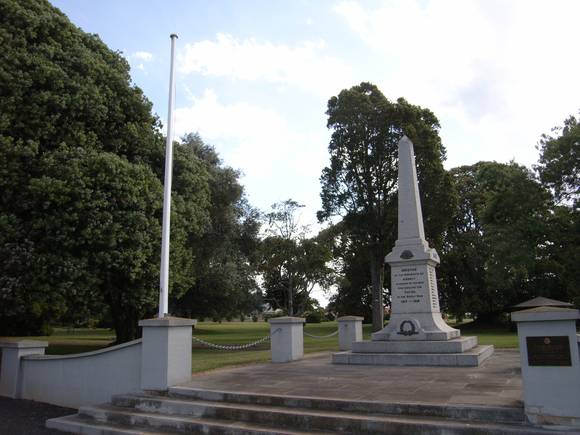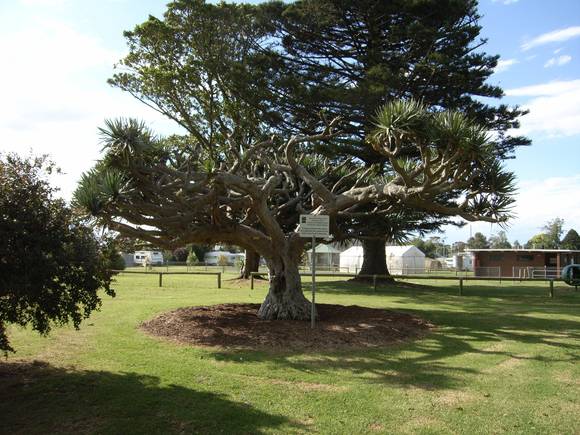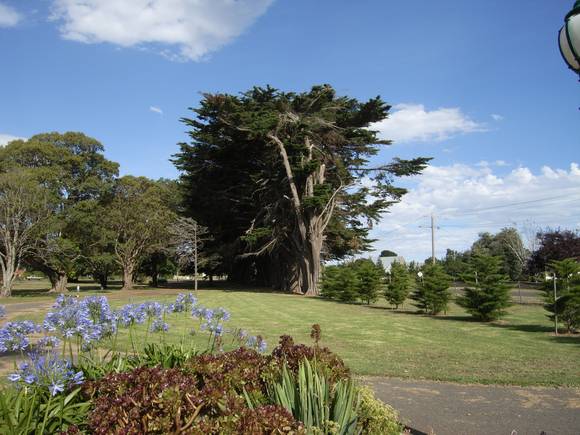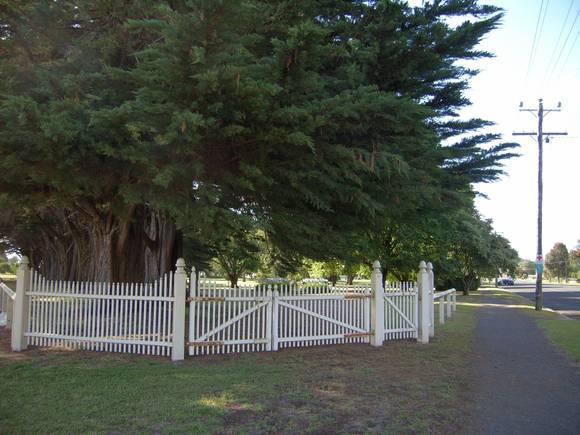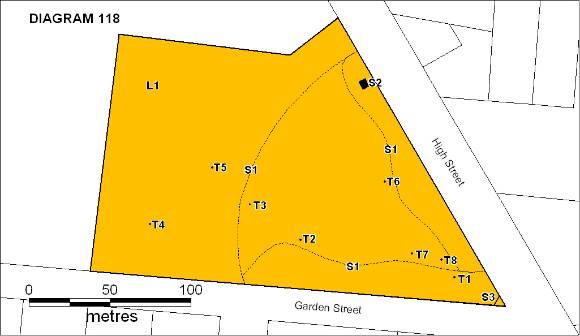| Back to search results » | Back to search page » |
|
KOROIT BOTANIC GARDENS
Other NameKOROIT BOTANICAL GARDENS LocationHIGH STREET KOROIT, MOYNE SHIRE
File Number600977LevelRegistered |
|
Statement of Significance
What is significant?
The Koroit Botanic Gardens is an outstanding, Guilfoyle inspired
provincial botanic garden which includes trees and shrubberies,
pathways; significant trees and the 1880 Guilfoyle plan. In 1857 the
district surveyor Thomas Watson provided a 20 acre allotment for
public gardens in Koroit immediately south of the National School
reserve. In 1873 the site was permanently reserved as a Public Gardens
and Recreation area. The northern portion, Victoria Park, was used in
the 1870s for sporting events. The south west section became a cricket
ground from about 1873 and is now the Jack Keane Oval. Little garden development occurred before 1866, but in the following
years beds were laid out and the first plantings occurred. In June
1870 Ferdinand von Mueller, Director of the Melbourne Botanic Gardens,
donated 190 plants to the Koroit Gardens. This is likely to have
included many conifer species, especially Pinus, Cedrus,
Cupressus and Araucaria. The first curator James
Mathewson from Warrnambool was appointed in May 1876. William Guilfoyle prepared a plan in 1880 for the Gardens, which
covered about 12 acres of the southern part of the reserve. The plan
retained many existing trees, mainly conifers, and proposed a new
serpentine pathway, shrubberies and perimeter planting. In addition to the fine specimen trees, the Gardens contained a great
variety of beds and shrubs, topiary and trellised roses and tree
ferns. Regular donations of plants from other botanical gardens, and
donations of plants from local residents, testify to the Gardens
important botanical and community role. In 1996, 55 plants were
received from the Royal Botanic Gardens as part of the Flora for
Victoria project. Today the Gardens have an outstanding collection of
conifers, figs, and a fine Draceana draco. In 1921 a memorial was proposed to honour 17 local men who lost their
lives in the First World War and in 1928 an obelisk was erected. In
1990 this was raised and placed on a larger base and partially
enclosed by a low wall. In 1937, new entrance gates were erected, the
D.S. Coto Memorial Gates, as a gesture of appreciation to former
doctor Daniel S. Coto. In response to the increasing popularity of
caravan holidays, the north west corner of the Gardens was used as a
caravan and camping ground in the 1950s. The Botanic Gardens land was re-reserved in 1961 for the purposes of
'Public Park and Recreation'.
How is it significant?
The Koroit Botanic Gardens are of historical, scientific and
aesthetic significance to the State of Victoria.
Why is it significant?
The Koroit Botanic Gardens are of historical significance as one of
the earliest provincial botanic gardens in Victoria, an integral part
of the 20 acre reserve within the 1857 township plan permanently
reserved for the purpose of Public Gardens and Recreation in 1873.
Botanic Gardens had already been established at Melbourne (1846),
Geelong and Portland (1851),White Hills (1854), Williamstown (1856),
Ballarat, Malmsbury and Hamilton (1857) and Warrnambool commencing in
1858 and in its current location since 1866. The Koroit Gardens are
important for the survival of plants provided by von Mueller from the
Melbourne Botanic Gardens in 1870, and the 1880 design by William
Guilfoyle. Guilfoyle was appointed Director of the Melbourne Botanic
Gardens in 1873 and redesigned the Melbourne Gardens over 36 years to
be one of the finest botanic gardens in the world. He is regarded as
one of Australia's greatest garden designers. The 1880 Guilfoyle plan, drawn by Robert Whitworth, is a rare
surviving 19th century landscape plan. The Koroit Botanic Gardens laid
out in the 1880s closely mirror the Guilfoyle plan up to the western
wind break. The Gardens is substantially intact to the 1880s plan
except for the area to the North West, currently used as a caravan
park. The caravan park sits within the realised planting scheme of the
1880s plan. Similar designs occur at Horsham (1880), but a smaller
area remains intact, and at Hamilton (1881). The Guilfoyle plan was
only partially implemented at Camperdown (1890) and Colac (1910).
Unfortunately no plans survive for Warrnambool (1877) and the Royal
Botanic Gardens (1873-1909) which is Guilfoyle's finest landscape. The Koroit Botanic Gardens are of aesthetic significance for the
layout and planting developed to a design prepared by William
Guilfoyle in 1880. The Guilfoyle landscape combines both picturesque
and gardenesque styles with serpentine gravel paths, sweeping lawns
dotted with eye-catching specimen trees. It is enclosed with a windrow
of Monterey cypress on the north, west and south, and with evergreen
and deciduous trees and shrubs on the east. Within the Koroit
landscape, the Gardens are of outstanding beauty and illustrate
seasonal change, contrasting plant forms and foliage, combined in a
unified landscape design. Local significance arises from the long
vista to the mature treed landscape of the Gardens, in contrast with
the generally flat, treeless, surrounding landscape. The Koroit Botanic Gardens are of scientific (botanical) significance
for their extensive collection of contributing trees and shrubs. The
outstanding collection of significant plantings include: Araucaria
columnaris, two A. cunninghamii, Cupressus torulosa, a rare
Rapanea howittiana,
Draceana draco (a world endangered species), Ficus platypoda
and Fraxinus ornus, all are the largest and finest in
Victoria. Contributory trees and shrubs include a variety of conifers;
Araucaria heterophylla, A. bidwillii, Agathis
robusta, two Cedrus altanica f. glauca, Cupressus
macrocarpa; two Ficus macrophylla and evergreen trees. Few
gardens in Victoria have the same number of significant trees in a
relatively small area.
Group
Parks, Gardens and Trees
Category
Garden Botanic


